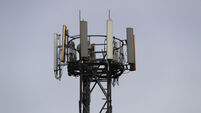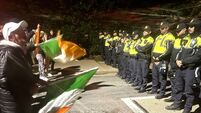German spy landings made Britain question Irish neutrality

With the Battle of Britain about to begin following the fall of France, the arrival of two German spies on the Dingle Penninsula — within a fortnight of each other in June 1940 — sparked enormous security concerns.
Walter Simon was seen coming ashore not far from Dingle and burying his radio transmitter on a beach in the early morning of June 13, 1940.
Then he walked toward Dingle on a railway line and asked some people what time the next train was due. It was 14 fourteen years since the last passenger train had run on the line.
Arriving in Dingle around 7am, he asked Michael Nelligan, the time of the next bus for Tralee. As the bus did not leave until 9am, Nelligan invited him for a drink in a local pub, where Simon consumed three glasses of whiskey and bought a full bottle of whiskey.
On the bus, he proceeded to drink from the bottle and even offered the whiskey to other passengers. He was clearly drunk when the bus dropped him at the railway station in Tralee.
He immediately attracted the attention of two Garda detectives, James Colley and Bill Walsh. They were staking out the station, as part of a widespread search of the Dingle Peninsula for the mysterious stranger.
The detectives were suspicious, seeing sand on Simon’s shoes. When he boarded the train for Dublin, they accompanied him and engaged him in conversation. He said he had been visiting his sister-in-law in Annascaul but got into an argument with her during the night and had decided to return to his family in Dublin.
One of the detectives telephoned Garda headquarters during a scheduled stop to warn of their suspicions. As a result, Simon was arrested on stepping off the train at Kingsbridge (now Heuston) Station.
He gave his name as Karl Anderson, but he was quickly identified as Walter Simon when the gardaí checked his fingerprints with the British. He had been deported from Britain in July 1938.
Simon was convicted of illegal entry and sentenced to three years in jail at the Central Criminal Court on July 8, 1940.
The other German spy dropped off from a U-boat was Willi Preetz, who came ashore near Minard 12 days after Simon. He managed to remain at large until late August. During that time, he transmitted some weather messages to Germany.
Although foreigners usually attracted attention in Ireland, Preetz, 34, was not initially suspected, because he was married to an Irish woman. He had married Sarah Reynolds of Tuam in Germany in 1935, and had visited the Reynolds family in 1937 and again in 1938. At the start of the war, he fled to Ireland from England.
The Reynolds family vouched that Preetz had returned to Ireland before the outbreak of the war, so he was allowed to remain. He slipped out of country in December 1939 and managed to return to Germany, where he joined the Abwehr, Germany’s military intelligence arm.
After being trained in the use radio equipment, Preetz returned to Ireland by U-boat on June 25, 1940, with the aim of sending weather information. He buried his radio transmitter on the beach near Minard after landing, and made his way to Dublin.
He returned to recover the transmitter a couple of weeks later, and began transmitting weather data to Germany upon his return to Dublin. He lived in a flat at 32 Westland Row.
He did not bother to buy any weather instruments, but merely took note of barometer readings in shop windows. He seemed more interested in partying than anything else. He did not endear himself to his wife’s family when he got her teenage sister Annie “into trouble”.
The British media seemed ready to believe any story about U-boats off the southwest coast, especially after the U-35 landed 28 Greek sailors at Ventry on October 4, 1939. The U-35 had sunk their ship off the coast of England and had rescued the sailors after one of their lifeboat overturned.
“Éire’s neutrality is rapidly becoming a farce,” Guy Liddell — the counter intelligence chief of Britain’s MI5 — noted in his organisation’s operational diary on October 12, 1939. “German sub sailed into Dingle for repairs.” There was no truth to that story, but such rumours were fuelled in the following days when Life, the popular American magazine, featured the U-35’s landing at Ventry as its cover story.
“Frequent reports coming about submarine bases on the west coast of Éire,” Liddell noted on October 28, 1939. There was no truth to this, or a subsequent MI6 report on January 12, 1940, of a supposed U-boat base near the mouth of the Doonbeg River in Co Clare.
“A submarine comes in three times a week and is camouflaged with a canvas screen,” Liddell recorded.
Bob Davis, an American author, wrote The Dingle War, a comic novel about a fictional character who supposedly supplied “Irish hams, sweaters, and whiskey” to the crews of U-boats that supposedly called regularly at Dingle during the war.
The fanciful rumours were fuelled by the landings of Simon and Preetz in June 1940. A Daily Mail correspondent reported that he heard stories in the remote bogs of Kerry about local fraternisation with U-boat crews that “would make any Briton’s hair stand on end.”
He did not suggest the U-boats were surfacing in bog holes, but that seemed to have been the implication. He added that he was shown a pub in Dingle where a U-boat captain proposed a toast to the downfall of John Bull.
In another pub, a man told him that a U-boat called regularly at a jetty on one of the islands to purchase fresh eggs and vegetables. “Come on, Maggie,” the submarine commander used to shout, “hurry up with those cabbages.”
The gullible journalist may have been paying for drink for his local informants, and the more he bought, the more exotic the stories became.
There was further alarm on September 27, 1940, when Timothy O’Shea and Timothy Crean, on lookout duty at Ardroe, reported that they saw a man coming ashore from a boat near Inch Strand at 1am.
“A thorough search of the peninsula from Dingle Bay to Tralee Bay was carried [out] on the 29th inst by 250 military accompanied by gardaí and local security forces,” said Garda Superintendent Michael Ó Laoghaire of Dingle, “but no trace of the man alleged to come ashore was found.”
Supt Ó Laoghaire believed the mystery man was either Michael Kennedy, or his brother John, who were out snaring rabbits on Inch Island that night. They were actually being interviewed by a garda sergeant as they were going home with their catch at 6.30am.
After investigating the U-boat stories for his book In Time of War, Robert Fisk wrote that Hugh Wren — an official coast-watcher who had served at various posts from Ballybunion to Dingle — dismissed the bulk of the U-boat stories. “Most of the submarines,” he said, “had been seen in pubs.”















